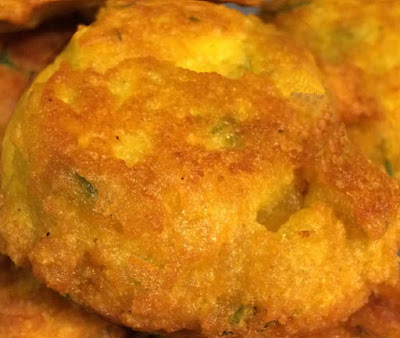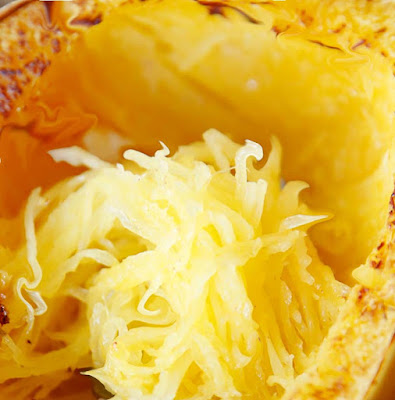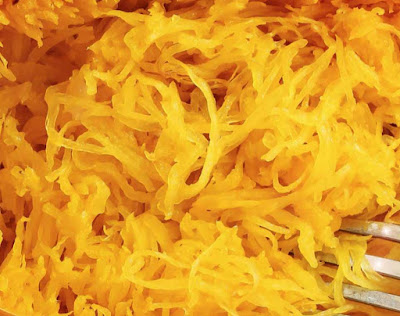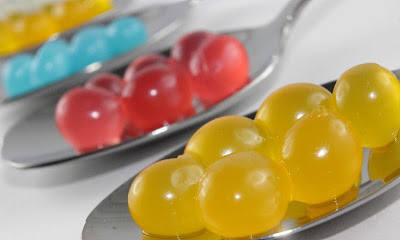Spaghetti squash fritters are easy to make and super delicious dish. It's a low carbohydrates, keto, grain free, dairy free, and gluten free.
This spaghetti squash fritters keto is one of best spaghetti squash recipe I tried. You can make a great extra crispy appetizer or healthy snack for the kids.
Don’t worry, cooked spaghetti squash is a great nutrient-packed healthier alternative to potato pancakes, pasta or rice noodles.
Spaghetti squash fritters keto, with creamy blue cheese (optional) and nutty nutmeg in the batter, are an intensely flavorful appealing side dish.
Just like potato latkes (or pancakes) are a special treat at Hanukkah, these squash fritters at Thanksgiving or Christmas have that same hot, savory crispness that pretty much guarantees your family members or friends will eat. Imagine their satisfied faces when eating your squash fritters creation.☺️
Serves 6
Cook Time: 35–40 minutes
INGREDIENTS:
1 medium spaghetti squash
1 scallion (green and white parts), thinly sliced on the bias
2 teaspoons garlic, minced
1 and 1/2 tablespoons fresh sage, chopped, plus whole leaves for garnish
1 and 1/8 teaspoon whole nutmeg, grated
1 teaspoon kosher salt or coarse sea salt
1/2 teaspoon freshly ground pepper
Zest of 1 orange
3–4 tablespoons all-purpose flour (You can substitute using coconut flour or almond flour)
1 large egg
4 ounces blue cheese, coarsely chopped or crumbled (This is optional)
Canola oil, for deep-frying
COOKING PROCEDURE:
1) Preheat the oven to 400 °F.
2) Cut the squash in half and remove the seeds.
What is the easiest way to cut squash? The first step is to put a towel down on your cutting board and then place your spaghetti squash on the towel to minimize rolling. Start by making several large slits through the skin with the tip of a sharp knife.
3) Season the spaghetti squash with salt and roast on a foil-lined half sheet pan for 30 minutes, until tender. Let cool. With a fork, scrape the squash to remove long strands and place on a towel.
To make spaghetti like strands, gently scrape the tines of a kitchen fork around the edge of the spaghetti squash to shred the pulp into strands.
4) Wrap the spaghetti squash in a kitchen towel and wring as much liquid out of it as possible, discarding the liquid.
5) In a medium bowl, combine the squash, chopped sage, nutmeg, scallion, garlic, salt, pepper, blue cheese, and all but 1 teaspoon of the orange zest. Stir in the egg and flour, and mix well until combined.
6) Add the canola oil to a large shallow pan two-thirds up the sides of the pan. Place the pan over medium-high heat. The oil should be heated to 360 °F for frying.
7) Drop spoonfuls of the squash mixture into the oil. Cook until the fritters are golden brown, about 4 minutes. After the fritters have cooked for 2 to 3 minutes, add some fresh sage leaves, but be careful because they will pop. Fry the sage leaves for a couple of minutes and remove with the fritters.
8) Drain the fried fritters and sage leaves on paper towels and season with salt.
9) Transfer the spaghetti squash patties keto or fritters to plates and garnish with the reserved orange zest and fried sage leaves. You can pair this fritter dish with Georgia Yellow Squash Casserole with Sour Cream. It will be a perfect match!
1) To make it one of the best spaghetti squash fritters recipes, it should be extra crispy. Squeezing out most of the water ensures the fritters get crispy and the spaghetti squash flavor is concentrated.
2) About 45 seconds before the fritters are done, put a bunch of sage leaves in the oil. Fried sage is a terrific garnish, and the flavor it releases into the frying oil (and then into the fritters) creates a mouth-watering and appetizing aroma.
3) Adding blue cheese to the spaghetti squash fritters creates a gooey interior and a crisp, frico-like exterior.
4) How to make spaghetti squash noodles? You can make squash look like spaghetti strands. If you are not familiar with spaghetti squash, the way you get those spaghetti-like strands is to roast the squash and then remove the cooked flesh of the squash by scraping it with a fork.
Check our other tasty Fritters and Squash Recipes:
How to Make Parsnip Fritters: Eat Nourish Glow Recipes
Quibebe- Pumpkin Soup- Brazilian Food Recipes
Patti Labelle's Easy Pumpkin Pie Recipe- Southern Soul Food
What's NEW in Oprah Winfrey's Favorite Indian Food Recipe?
Can you overcook spaghetti squash?
As with all vegetables, squash and pumpkins should not be overcooked or submerged in boiling water since this will result in the loss of both essential nutrients and flavor.
The key concern with spaghetti squash is that it's easy to overcook. Cooking the squash al dente is practically an art. If I'm making your favorite casserole, don't worry about overcooking the spaghetti squash, because it really doesn't matter. If you are going for al dente noodle-like strands, I pay close attention to cooking times.
Most people bake, broil, pressure cook, or steam them before using in a recipe, but squash can be peeled and cut up for cooking in a small amount of water or broth.
What is a serving size of spaghetti squash?
Other common serving sizes:
|
Serving Size
|
Calories
|
|
1 oz
|
13
|
|
100 g
|
47
|
|
1 cup of
|
75
|
|
1 squash yields
|
478
|
Is spaghetti squash healthy?
Spaghetti squash is a winter vegetable rich in important vitamins, minerals, and antioxidants. Due to its low calorie and high fiber content, it may help in weight loss and digestive health. Try roasted spaghetti squash recipes as a low-carb alternative to pasta, combined with veggies, protein, whole grains, and healthy fats.
SPAGHETTI SQUASH CALORIE COUNTER:
Spaghetti squash contains many nutrients, including folic acid, potassium, vitamin A, and beta carotene. It is low in calories, averaging 42 calories per 1-cup (155 grams) serving.
Spaghetti squash, raw
Nutritional value per 100 g (3.5 oz)
|
Energy
|
130 kJ (31 kcal)
|
|
|
|
|
|
|
Carbohydrates
|
6.91 g
|
|
|
|
|
|
|
Sugars
|
2.76 g
|
|
|
Dietary fiber
|
1.5 g
|
|
|
Fat
|
0.57 g
|
|
|
|
|
|
|
Protein
|
0.64 g
|
|
|
|
|
|
|
Vitamins
|
Quantity
|
%DV†
|
|
Vitamin A equiv.
|
6 μg
|
1%
|
|
beta-Carotene
|
64 μg
|
1%
|
|
Thiamine (B1)
|
0.037 mg
|
3%
|
|
Riboflavin (B2)
|
0.018 mg
|
2%
|
|
Niacin (B3)
|
0.95 mg
|
6%
|
|
Pantothenic acid (B5)
|
0.36 mg
|
7%
|
|
Vitamin B6
|
0.101 mg
|
8%
|
|
Folate (B9)
|
12 μg
|
3%
|
|
Vitamin C
|
2.1 mg
|
3%
|
|
Vitamin E
|
0.13 mg
|
1%
|
|
|
|
|
|
Minerals
|
Quantity
|
%DV†
|
|
Calcium
|
23 mg
|
2%
|
|
Iron
|
0.31 mg
|
2%
|
|
Magnesium
|
12 mg
|
3%
|
|
Manganese
|
0.125 mg
|
6%
|
|
Phosphorus
|
12 mg
|
2%
|
|
Potassium
|
108 mg
|
2%
|
|
Zinc
|
0.19 mg
|
2%
|
|
Units
μg = micrograms • mg = milligrams
IU = International units
|
||
|
†Percentages are roughly
approximated using US recommendations for adults.
Source: USDA Nutrient Database
|
||
Is spaghetti squash a good carb? YES
Due to optimum fiber content make it a popular low-carbohydrates, low-fat, gluten-free, and vegan alternative to pasta, rice, bread and noodles.
What does spaghetti squash taste like?
Netizens and youtubers have described the taste as similar to yellow winter squash, a bit sweet, and slightly crunchy, among other things. If you're disappointed that spaghetti squash doesn't have the taste or texture of normal pasta, don't be sad. You will get used to it the second try.
Do you like healthy fries? You should check these recipes. I would take just 5 minutes of your time.
How to Make Chrissy Teigen‘s Zucchini Fries? - Chrissy Teigen Cookbook Recipes
How to Make TGI Fridays Crispy Green Bean French Fries?
How do you know if Spaghetti squash is ripe?
When the squash has turned a golden yellow or a dark yellowish color, it is usually ready to be picked. The skin of the squash will be very thick and tough. If you use your fingernail to poke the squash, you will know it's ripe if your nail doesn't pierce the squash.
Spaghetti squash or vegetable spaghetti can come in a variety of shapes, sizes, and colors, including ivory, yellow and orange, with orange having the highest amount of carotene. Its center holds many large seeds and when raw, the flesh is solid and similar to other raw squash. When cooked, the meat of the fruit falls away from the flesh in ribbons or strands that look like noodles.
How long does spaghetti squash last? Eat cooked spaghetti squash within 3 to 5 days of putting it in the refrigerator.
Store whole raw spaghetti squash at room temperature up to 3 weeks. Spaghetti squash is available year-round with peak season in fall.
Ideal storage conditions for these vegetables is in a cool, dry place, just about 50°F., 50–70 percent humidity, with moderate air circulation. A basement or an attic with a fan might be just the perfect solution. They should be set securely on shelves or table, not touching each other.
Outside storage might run the risk of freezing your vegetables, and inside the home where temperatures run above 55°F will cause the vegetable spaghetti to get stringy.
Even under the most excellent conditions pumpkins and winter squash will not stay perfect for 10 years. Eventually the starch content will turn to sugar and the water content will increase. That's why some people freeze, dry, can, or pickle some pumpkin or squash to use during the late winter months.
You can also cook spaghetti squash recipes and then store it in the freezer for weeks.
REFERENCES:
Julie Hatfield. 2015. The Pumpkin Cookbook: Top 50 Most Delicious Pumpkin Recipes [Breakfast - Snacks - Entrées - Desserts - Beverages] (Recipe Top 50s Book 120) Kindle Edition. Otherworld Publishing. ASIN: B0170HICPK
Mary Anna Dusablon. 1980. Cooking with Winter Squash and Pumpkins: Storey's Country Wisdom Bulletin A-55. Storey Publishing. LLC. ISBN-10: 0882662309
The Chew Authors: Carla Hall, Clinton Kelly, Gordon Elliott, Daphne Oz, Mario Batali, Michael Symon. 2012. Chew: Fall Flavors: More than 20 Seasonal Recipes from The Chew Kitchen (Digital Picture Book) Kindle Edition. Kingswell. ASIN: B01DJX59QO







